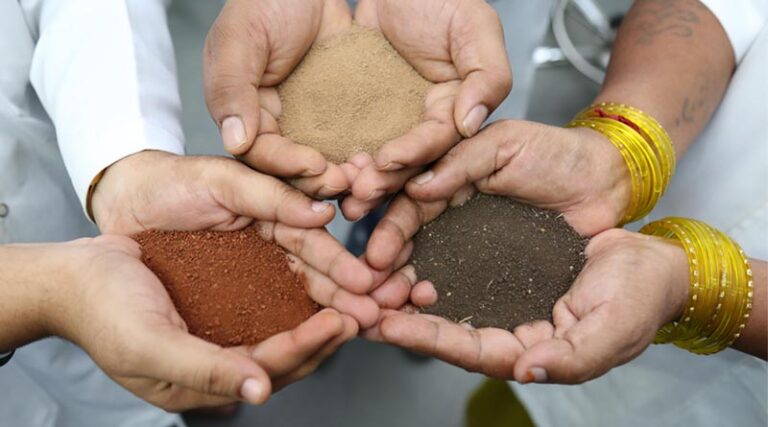
What Really Builds Healthy Soil?
Opinion piece by Dr. Mukund Dhavaji Patil, Senior Scientist – Soil Physics.
05 November 2025, New Delhi: Around the globe, regenerative agriculture is gaining momentum as a powerful solution to some of our biggest challenges. Heralded for its potential to restore ecosystems, improve soil health, and sequester atmospheric carbon, it represents a hopeful path toward a more sustainable and climate-resilient food system.
By moving beyond simply sustaining productivity to actively rebuilding the land, these practices promise to turn farms into powerful tools for environmental restoration.
But while the promise of regenerative agriculture is universal, its effectiveness is not. The benefits of a specific practice, like no-till farming, can vary dramatically based on climate, soil type, and duration. To clear up this puzzle, a massive new meta-analysis synthesized the results from 147 peer-reviewed studies across India’s diverse landscapes.
The findings provide some of the clearest, and most surprising, evidence to date on what truly works to build healthy, carbon-rich soil.
Four Surprising Takeaways from the Forefront of Soil Science
Takeaway 1: The Tillage Paradox — Why Less Tillage Isn’t a Silver Bullet on Its Own
One of the most widely promoted regenerative practices is conservation tillage (reducing or eliminating plowing). The logic is simple: not disturbing the soil helps protect its structure and the carbon stored within. However, this study revealed that when implemented as a standalone strategy, zero or minimum tillage had a relatively lower impact on building soil organic carbon (SOC) compared to other methods.
Even more surprising, the analysis found that the effectiveness of this practice could decline in the medium term (10-20 years). This may be because farmers sometimes interrupt no-till periods with conventional tillage to manage weeds or soil compaction, which can negate previously accrued carbon benefits. The study’s key insight is that the true power of reduced tillage is unlocked only when it is part of a systems-level strategy. No-till protects the soil’s physical structure, but it requires organic inputs like crop residue to provide the actual building blocks. This combination yields powerful synergistic benefits and creates sustained, long-term gains.
The standalone effect of zero or minimum tillage on building soil carbon may be limited; its true potential is realized when integrated with organic matter inputs to deliver sustained SOC gains.
Takeaway 2: The Unsung Heroes- Not All Organic Matter is Created Equal
Adding organic matter to the soil is a cornerstone of regenerative farming, but this study shows that the type of amendment matters immensely. Technically, biochar application showed the highest potential effect size (14.4). However, the researchers caution that this finding is based on short-term studies, and biochar faces significant practical challenges, including high production costs and limited accessibility for smallholder farmers, which may constrain its widespread adoption.
When it comes to proven, accessible, and powerful tools, manure-based amendments are the clear winners. The analysis found that Farmyard Manure (FYM) and green manure (crops grown specifically to be incorporated into the soil) delivered substantial and consistent increases in soil carbon.
To put numbers on it, FYM showed a powerful effect size of 8.92, with green manure also delivering substantial gains (6.56), while compost’s impact was more moderate (5.07), likely due to high variability in its composition and application. This provides a crucial distinction, emphasizing that consistent applications of high-quality manure are a key driver of soil regeneration for farmers right now.
Manure-based amendments, particularly Farmyard Manure (FYM), are crucial for building soil carbon stocks, reinforcing the evidence that consistent, high-quality organic matter inputs are a cornerstone of soil regeneration.
Takeaway 3: The Power of Patience – The Biggest Gains Take a Decade or More
In a world that often demands immediate results, this study serves as a powerful reminder that ecological restoration is a long game. While regenerative practices can yield considerable gains in soil carbon in the short term (under 10 years), the most significant and stable increases occur over much longer timelines.
The data revealed that the most pronounced and stable gains were in experiments running for over 20 years, with effect sizes peaking in studies lasting 20-40 years and beyond. This aligns with the science of soil formation, which is a slow, cumulative process that eventually stabilizes as soil reaches its carbon saturation point. This finding has profound implications for both farmers and policymakers. It underscores that a long-term commitment is essential for true soil transformation and that policies must be designed to provide the stable, long-term support needed to see these efforts through.
Soil carbon accumulation is a marathon, not a sprint. The greatest benefits of regenerative practices are realized over decades, highlighting the need for long-term vision and commitment.
Takeaway 4: Context is King – Where You Farm Matters as Much as How
Perhaps the most important finding from the analysis is that there is no one-size-fits-all solution in regenerative agriculture. The study documented substantial variations in how well different practices worked across India’s diverse agro-ecological regions, proving that what works in one valley may have limited success in another.
The researchers identified “SOC hotspots”, regions like the Eastern Plain (AER-13) and the Western Ghats and Coastal Plains (AER-19), which showed exceptional potential for carbon sequestration due to favorable rainfall and intensive cropping systems. In contrast, semi-arid plateaus or high-altitude Himalayan zones showed more moderate gains, constrained by factors like limited water or low temperatures. This finding strongly argues against blanket policies and instead calls for tailoring regenerative strategies to fit local climate, soil, and farming system conditions.
Blanket approaches to regenerative agriculture are suboptimal. To maximize carbon outcomes, practices must be tailored to specific regional conditions, from humid “hotspots” to arid landscapes.
From Universal Promise to Tailored Solutions
The key message from this analysis isn’t simply that regenerative agriculture works, but that how it works is more nuanced and sophisticated than we often assume. Practices like adding high-quality manure, retaining crop residues, and reducing tillage consistently build soil carbon.
However, the study’s deeper message is a call for nuance. The success of these powerful tools hinges on moving beyond simple, universal prescriptions to embrace a more sophisticated approach, one that is synergistic, long-term, and tailored to the unique ecology of each farm.
The findings challenge us to think more critically about how we implement and incentivize soil health. As we look to scale these nature-based solutions, how can we best design policies and carbon markets that reward not just the adoption of a practice, but the measurable, context-aware, and lasting health of the soil itself?
Also Read: India Enforces 30% Import Duty on Canadian Yellow Peas, Impacting Global Pulse Trade
📢 If You’re in Agriculture, Make Sure the Right People Hear Your Story.
From product launches to strategic announcements, Global Agriculture offers unmatched visibility across international agri-business markets. Connect with us at pr@global-agriculture.com to explore editorial and advertising opportunities that reach the right audience, worldwide.






